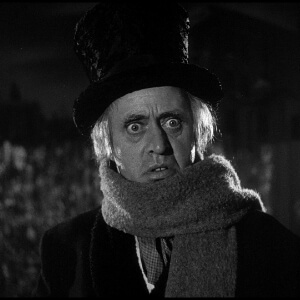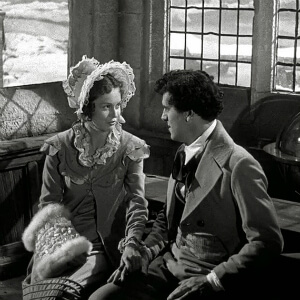“We spirits of Christmas do not live only 1 day of our year, we live the whole 365. So is it true of the child born in Bethlehem: He does not live in men’s hearts only 1 day of the year, but in all the days of the year” — Spirit of Christmas Present
With that sentiment in mind, let’s talk about a Christmas movie in January. Namely, the 1950s adaptation of A Christmas Carol directed by Brian Desmond Hurst and starring Alastair Sim as the iconic miser. Interestingly enough, its screenplay is written by Noel Langley, who did The Wizard of Oz and Snow White and the Three Stooges. Do with that information what you will.
Carol is one my favorite stories in any format. I find it one of the most fascinating pieces of art in regards to the spontaneous way it came about compared with its monumental effect on western culture. As everyone knows, there has been a plethora of film adaptations and homages of the story, but in my opinion, the 1951 version is the only one that got the heart of the story most on point. For the past few years, it has become one of my favorites to watch every December. Allow me to geek out about it for a bit.
Christmas Camp
The hardest thing to get past with this particular iteration is the cheapness of it by today’s standards. It’s black-and-white, has some really bad cuts, cheesy effects, and a few pretty corny acting moments. Obviously, it was made in the early 1950s, so of course it’s going to look and feel quite different than even the 80s TV movie starring George C. Scott, let alone Robert Zemeckis’ ridiculously over-the-top 3D extravaganza. But, I think its campiness is what appeals to me about it. Carol is a story so ingrained in our cultural conscious, that it’s hard to tell it in a way that feels genuine anymore.
 In fact, that’s the word I would use to describe this film: Genuine. Sure, the acting, dialogue, and effects can be a little hokey, but it’s not trying to dazzle you, it’s simply telling the story of this cynical old rich man in a snowy Victorian-English town who gets haunted by ghosts on Christmas and changes into a better man. Without all the bells and whistles telling you this is a new take on this story, the emotions and the meat of what makes the story special has a more direct streamline into your heart.
In fact, that’s the word I would use to describe this film: Genuine. Sure, the acting, dialogue, and effects can be a little hokey, but it’s not trying to dazzle you, it’s simply telling the story of this cynical old rich man in a snowy Victorian-English town who gets haunted by ghosts on Christmas and changes into a better man. Without all the bells and whistles telling you this is a new take on this story, the emotions and the meat of what makes the story special has a more direct streamline into your heart.
Identifying With a Villain
Scrooge is normally introduced in movie adaptations as a total villain. In this version, the portrayal is relatively modest. He’s just a businessman with a cynical worldview. The line, “If they are to die, they had better do it, and decrease the surplus population,” is normally delivered in a way that’s meant to be shocking; the moment when the audience officially knows this is a bad dude, but in this version, he just says it. Like that. That’s just how he feels.
This nonchalant delivery resonates because, speaking for myself, I know there are areas of my heart that want to build a personal philosophy that doesn’t require me to care. The world is so overwhelmingly broken and full of pain and evil, that it’s easy to feel the compulsion to ignore it altogether. “(My business) occupies me constantly,” as Scrooge remarks. Thus, not having to care about people would be awfully convenient. But, God’s word presents a different philosophy; one of compassion and self-sacrifice. So, if I’m going to call myself a follower of Christ, that mindset won’t fly. Instead of building ourselves up, we ought to primarily try to build others up. And if everyone in the world did so, we might not even have to think about building ourselves up in the first place.
In regards to the story’s effectiveness, introducing Scrooge as a 2-dimensional hater of all things joyful takes away from the impact of his redemptive arc. The first step in change is identifying the problem. In the beginning of the story, the viewers might be interested in seeing where this crotchety man’s story goes, especially when the box-cover promises that he will be smiling and holding a crippled child on his shoulders by the end, but they most likely won’t look at him in the beginning and go, “That’s me.” At least, not consciously. No one inherently wants to identify with a villain, so if you don’t give them a reason to, they won’t.
Backstory
This version of the story dwells in the past segment longer than most, even adding quite a bit of material not found in the book. But doing so benefits it as a retelling of the story in the medium of film. The past is the most important part of Carol, in my opinion. At least, it’s the part that has the most emotional impact on the rest of the story. Thus, in a visual medium, the choice to show a lot of the details about Scrooge’s past that are only given a mention in the book is a smart one.
 For instance, a pivotal moment in Scrooge’s backstory is the death of his sister, Fan. In the book, and in most adaptations, the Spirit of Christmas Past mentions that she dies, but in this one, we see the death scene, and it leaves an emotional impact. It’s odd to find such a sad melancholic segment in a Christmas movie, but the sad moments highlight the redemptive aspects of the story. The inspirational intentions of the story are most effective when it acknowledges the hardship of the world before showing you that it can get better.
For instance, a pivotal moment in Scrooge’s backstory is the death of his sister, Fan. In the book, and in most adaptations, the Spirit of Christmas Past mentions that she dies, but in this one, we see the death scene, and it leaves an emotional impact. It’s odd to find such a sad melancholic segment in a Christmas movie, but the sad moments highlight the redemptive aspects of the story. The inspirational intentions of the story are most effective when it acknowledges the hardship of the world before showing you that it can get better.
The benefit of the in-depth past segment is that we get to see Scrooge’s full descent from a young man with romantic assumptions about life to someone who tries desperately to make himself invulnerable, and by doing so, shutting out everyone from his life. This iteration takes us all the way up to Marley’s death scene, and the screenplay beautifully puts Dickens’ opening descriptor of Scrooge into the mouth of the Spirit: “Look at your face, Ebenezer. The face of a wrenching, grasping, scraping, covetous old sinner.” Scrooge is disturbed by this self-reflection, and the softening of his heart is evident.
Complacency
The climatic future segment includes my favorite change from the book, one that made me find the book’s version unrealistic. Scrooge is always compliant by the time he gets to the Spirit of Christmas Yet to Come, but in this version, he fearfully pleads to the ghost, “I’m too old! I cannot change.” This rings true about the nature of people going through a change of heart. We might accept that our way of life stinks; that it might be hurting people around us, and maybe even ourselves, but we are often still complacent. Change is scary, even when change could mean more joy and fulfillment. We’re stubborn like that. We’ll sit around being miserable quicker than we’ll accept a call to a better life, and we’ll use the excuse of either being too young or too old in order to keep it that way. Just as Paul describes in the book of Romans, “For in my inner being I delight in God’s law; but I see another law at work in me, waging war against the law of my mind and making me a prisoner of the law of sin at work within me” (Romans 7:22-23).
And now that I’ve seen the story told this way, I find it hard to believe someone in Scrooge’s position would be willing to let this Spirit try to change his ways, even after having his heart softened by what the previous two ghosts showed him. It just makes sense and feels real to me.
Infectious Joy
So that’s what makes this Christmas movie so great, right? It reminds us all of the worst parts of ourselves. Sounds festive.
 No, here’s where the movie really becomes one of my favorites to watch on Christmas. In the final scenes when Scrooge officially turns around a becomes, whom I like to call, “Happy Scrooge,” Sim goes nuts. It is the most infectiously joyful performance of Happy Scrooge I’ve ever seen. Before I saw this film, every iteration of the ending scenes felt a little fake in the back of my mind. All Scrooge seemed to want was to be left alone, then all these annoyingly uppity folks barged into his world and tried to force him to be happy, then some ghosts did it and threatened damnation, and then Scrooge became an obnoxious goody two-shoes just like everyone else around him. I knew objectively that love and redemption were what the story was about, but it never resonated with me until I saw this movie. Sim’s Scrooge is genuinely a different, happier person in the end. The wealth and the solitude he was clutching onto so tightly was hurting him more than it hurt anyone else.
No, here’s where the movie really becomes one of my favorites to watch on Christmas. In the final scenes when Scrooge officially turns around a becomes, whom I like to call, “Happy Scrooge,” Sim goes nuts. It is the most infectiously joyful performance of Happy Scrooge I’ve ever seen. Before I saw this film, every iteration of the ending scenes felt a little fake in the back of my mind. All Scrooge seemed to want was to be left alone, then all these annoyingly uppity folks barged into his world and tried to force him to be happy, then some ghosts did it and threatened damnation, and then Scrooge became an obnoxious goody two-shoes just like everyone else around him. I knew objectively that love and redemption were what the story was about, but it never resonated with me until I saw this movie. Sim’s Scrooge is genuinely a different, happier person in the end. The wealth and the solitude he was clutching onto so tightly was hurting him more than it hurt anyone else.
One of my favorite moments in this film, which is unique to this version only, is when he sits back down to his desk for the first time in his new state of mind and mutters, “I don’t deserve to be so happy,” then, as he starts chuckling to himself, states, “I can’t help it. I just can’t help it!” Beautiful.
For what it is, the heart of this piece rings true, and I would definitely recommend adding it to your watchlist for next Christmas season. Or you could use it as another excuse to put off taking down your Christmas lights. That works as well.





